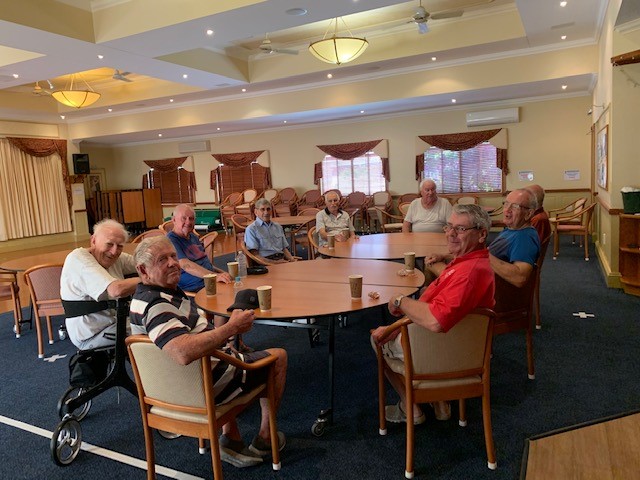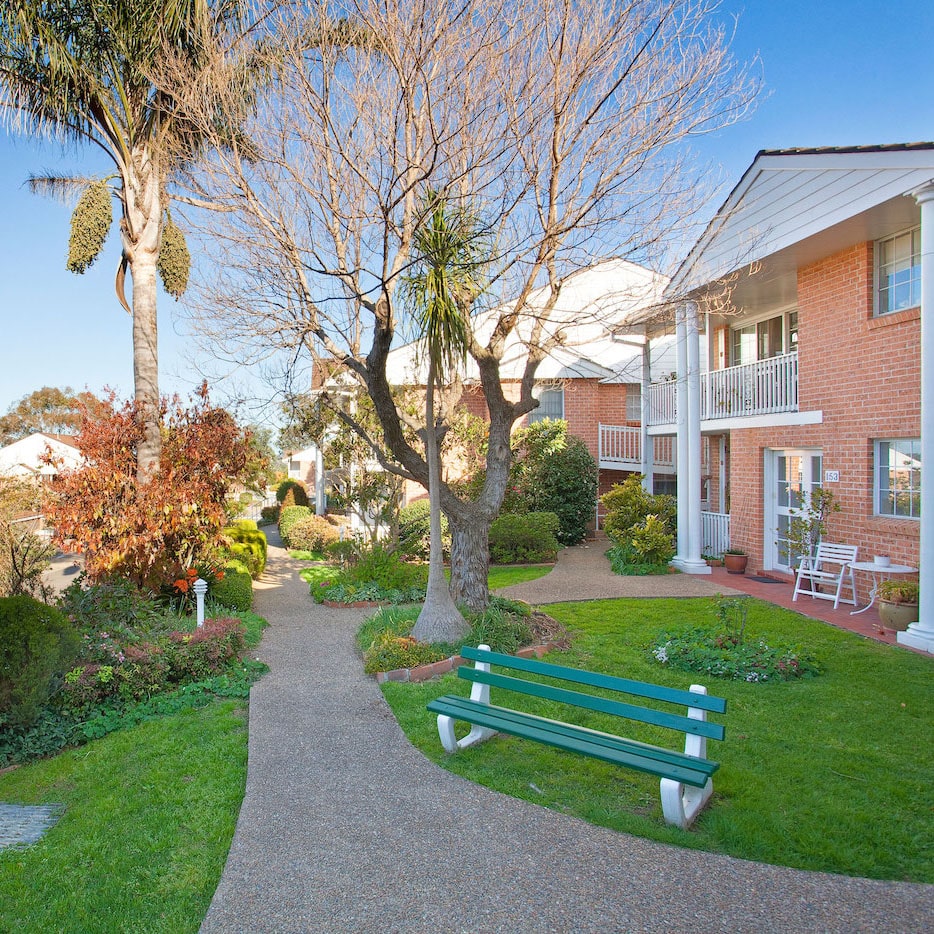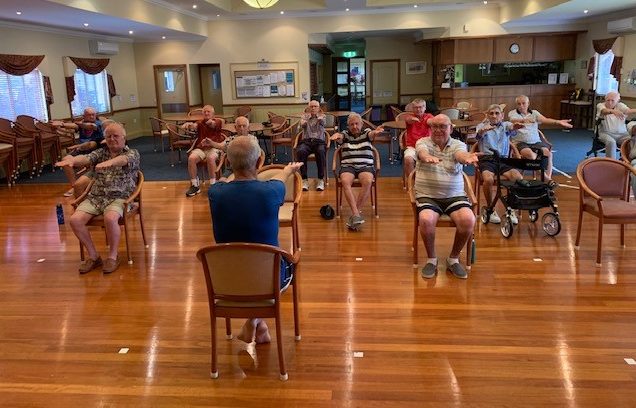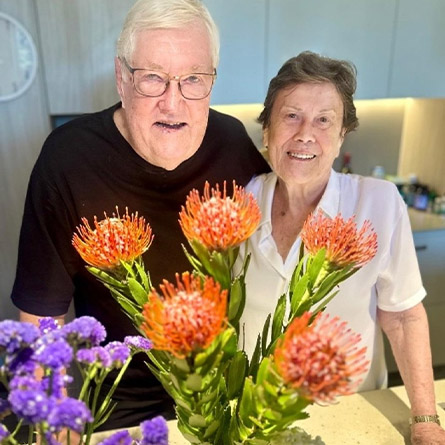Marty’s story
Marty has seen first-hand the mental and physical benefits of an exercise program. He’s no stranger to injury, and credits hydrotherapy for drastically improving his mobility after a work injury 20 years ago. “The pool was the best thing for me,” he says. “Exercise totally improved my quality of life. If I didn’t do it, I wouldn’t be where I am today.” Read Marty’s tips for getting started
Now, he exercises for around an hour five times a week, combining regular swims with the treadmill and rower in the gym. For Marty, mental and physical health go hand in hand, and he finds that exercise can be calming and meditative. “Exercise relieves a lot of stress for me. It gives me time away – I can get in the pool and swim 2km, and all I’m thinking about is following the black line.”
When Marty and his wife Margaret moved into Wellington Manor 18 months ago, Marty discovered there were no groups exclusively geared towards the male residents. “The ladies had aqua aerobics but there was nothing just for the men. I thought it would be good to start something for the gentlemen, so they could come have a chat, have a cuppa and do some exercise.”
From here, the men’s exercise group was born. Every Tuesday morning, Marty leads a group of around 20 residents through a series of stretches and gentle exercises. The classes focus on stability, balance, mobility, concentration and coordination, and Marty has seen a huge improvement in some of the regulars.
“It gets the brain working as well as the body,” he says. “At the beginning, some of the men were a bit unsteady. Now, they’re like dancers in a couple of the exercises, and I can see their concentration and focus improving.”
The consistency of the exercise classes has also done wonders for the group’s motivation. “They used to get here at 9am on the dot, now they arrive 15 minutes early and stay for a cuppa afterwards,” Marty says.

A couple of participants use walkers, and tell Marty that the exercises he includes are just like the ones prescribed by the physio. “They tell me they’re more flexible, and their concentration and mobility are improving.”
The class has been so popular that it’s now expanded to an additional class on Friday mornings, which is a more advanced session that is also open to women. While the residents get a great deal out of the mornings together, it’s clear that Marty does too.
“I just love it,” says Marty. “It’s all a giggle too. We have a bit of a laugh in the place. That’s all it’s about – mental health and physical health, that’s all I wanted to do.”
Marty’s top tips for getting started
1. The first step is the hardest. Exercise is as much of a mental game as it is a physical one, and it’s easy to talk yourself out of going. As Marty says, “the hardest part of coming to exercise class is going outside your front door. I say to the residents, ‘you’ve made the effort to get here, let’s do something about it. You’ve passed the hardest part.’” Do whatever it takes to make that first step, whether that’s setting a reminder on your phone, getting your clothes ready the night before, or arranging to meet a friend for coffee after the exercise class.
2. Make connections. “Group participation accounts for a lot,” says Marty. He recognises that a lot of people don’t want to exercise by themselves, so encourages finding a like-minded exercise group to join. If group exercise isn’t your style, find a friend, partner, neighbour or family member to exercise with. That way, you’ll find it much easier to stay accountable and stick to your goals.
3. Listen to your body. Residents at Wellington Manor are lucky that Marty runs an inclusive and welcoming class. “At first, people wouldn’t come because they didn’t think they could do it. But it’s not pushy here, people go at their own pace. I just tell them to do what they can.” Try to find a suitably welcoming environment, ideally with an instructor who’s used to teaching seniors. As Marty says, “I don’t know your body. You know your body. If it doesn’t suit you, stop.”
4. Make small and consistent changes. When Marty faced injury in the past, he knew he had to take his recovery slowly and gently build up the exercises over time. He applies this same philosophy to starting exercise after an absence, particularly if you’re over 65. “Start with a little walk in the morning or the afternoon,” Marty suggests, “and gradually build from there.” It’s better to start slow and set realistic goals at the outset. “Consistency is the key,” says Marty. “You’re better off setting weekly goals that you can reasonably achieve, not trying to do what you did 20 years ago.”
5. Find something you enjoy. There’s no point pounding the pavement if it hurts your knees or if it it’s just not enjoyable. Consider other alternatives you might prefer, such as swimming, Pilates, dancing, golf or yoga. If you can find something you love, chances are much better that you’ll stick to it.
6. Pace yourself. Understand that at first, exercise might feel like a chore. “At the start, it can feel like a burden,” Marty says, but eventually “you go from a burden to a willingness.” He estimates it might take 6-8 weeks for the body to start working better and to really enjoy the exercise itself. “But once you get to that point, you’ll start to get a rhythm of the body and routine. Then if you don’t go, you miss it.”
We’ve been inspired by Marty’s dedication to teaching his fellow residents at Wellington Manor, and hope his practical tips inspire you to get your body moving too.
Not receiving our Vitality monthly newsletter yet? Share your details below and we’ll send you monthly updates, helpful tips, and inspiring stories to support you on your retirement journey.
Find a home that's right for you
RetireAustralia owns and operates retirement villages in 30 unique urban, seaside, tree-side and regional locations.








